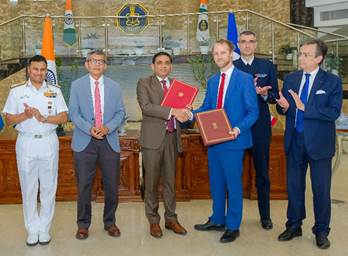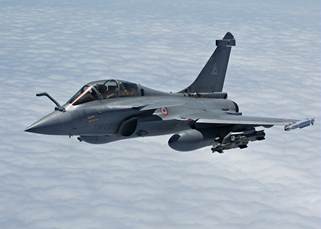Rafale-Marine: Enhancing India's Naval Strength
Summary:
- India signed a ₹63,000 crore deal with France in April 2025 for 26 Rafale-Marine jets.
- These jets can operate from aircraft carriers and are built for naval missions.
- The deal includes training, weapons, simulators, and long-term support.
- Rafale-Ms will be deployed on INS Vikrant and INS Vikramaditya.
- India earlier bought 36 Rafale jets for the Air Force in 2016.
- The new deal includes technology transfer to boost Indian defence manufacturing.
- Rafale-M strengthens India’s naval power until its own fighter jet is ready.
Introduction
On 28th April 2025, India signed a significant defense agreement with France to procure 26 Rafale-Marine fighter jets, valued at approximately ₹63,000 crore. This includes 22 single-seat jets and 4 twin-seat jets. This deal marks India's first acquisition of the naval variant of the Rafale, making it the first international operator of this model. The deal also covers pilot training, flight simulators, weapons, essential equipment, and long-term maintenance support. In addition, it includes extra gear for the Rafale jets already being used by the Indian Air Force. In line with the Government's thrust on Aatmanirbhar Bharat, the agreement includes Transfer of Technology for integration of indigenous weapons in India.

Rafale-Marine: Indian Navy’s Next-Generation Fighter Jet
The Rafale-Marine (Rafale-M) is a powerful, advanced fighter jet designed to operate from aircraft carriers at sea. Unlike regular fighter jets that take off from land, this aircraft can launch from and land on moving ships, even in tough sea conditions. It is built by Dassault Aviation of France and is already getting used by the French Navy.
The Indian Navy currently operates two aircraft carriers, INS Vikrant and INS Vikramaditya. The recent agreement for the procurement of 26 Rafale-M aircraft from France will enhance the Navy’s fleet, with these jets capable of operating from both carriers. The Rafale-M jets will be used for missions like air defence, maritime strike, reconnaissance, and shore strikes. The aircraft will help the Navy target enemy fighter jets, ensuring the air defence capability of the fleet and allowing the Navy to exercise control over the seas while staying outside enemy weapon ranges. The Rafale-M jets will also improve the Navy’s ability to prevent adversaries from gaining maritime domain awareness, weakening their ability to provide targeting information to other platforms. These aircraft’s induction will greatly enhance the Navy’s overall operational reach and strength.


Key Features:
- Carrier Compatibility: Reinforced landing gear and a tail hook enable safe takeoffs and landings on aircraft carriers.
- Advanced Avionics: Equipped with the Thales RBE2 AESA radar and SPECTRA electronic warfare suite for enhanced situational awareness and survivability.
- Multirole Capability: Capable of air superiority, ground attack, reconnaissance, and anti-ship missions.
- Armament: Can carry a variety of weapons, including air-to-air missiles (MICA, Meteor), air-to-ground missiles (SCALP-EG), and anti-ship missiles (Exocet AM39).
- Performance: Maximum speed of Mach 1.8 (approximately 1,912 km/h) and a service ceiling of 50,000 feet.
Rafale Deals by India
India’s journey with the Rafale fighter aircraft began in 2016 when the government signed a deal with France to purchase 36 jets, aimed at strengthening the country’s defence and enhancing the capabilities of the Indian Air Force (IAF). The first five Rafale jets arrived in India in July 2020 and were stationed at Air Force Station Ambala, later joining the 101 Squadron in West Bengal. These jets were initially used for training Indian pilots and technicians in France before being inducted into the IAF.
The deal for these 36 Rafale jets was different from the earlier plan to buy 126 aircraft. While the original plan involved 108 planes to be built in India, the new agreement focused on 36 jets being directly delivered from France. This deal included better pricing, maintenance terms, and additional support like weapons and simulators. Over the years, the collaboration between India and France has also extended to other defence projects, such as submarines.
By 2030, India will have a total of 62 Rafale jets in service, including 26 Rafale-M aircraft, making it the first country to operate both versions of the Rafale aircraft after France. The addition of the Rafale-M will significantly strengthen India’s air and naval power, ensuring dominance in both the skies and at sea, while reinforcing the nation's sovereignty.
Strategic Importance for India
Enhancing Naval Capabilities: The introduction of the Rafale-Marine will significantly bolster the Indian Navy's operational capabilities, particularly in the Indian Ocean region. It addresses the limitations of the existing MiG-29K fleet and provides a modern, reliable platform for various missions.
Boosting Indigenous Defence Industry: The deal includes provisions for technology transfer and the establishment of maintenance and production facilities in India. This initiative is expected to create thousands of jobs and promote self-reliance in defence manufacturing. With the induction of Rafale Marine aircraft, the strength of the Navy will increase manifold, and these fighter aircraft will be deployed on aircraft carriers like INS Vikramaditya and INS Vikrant. Rafale will be equipped with advanced weapon systems and missiles.
Interim Solution for Future Development: While India is developing its own Twin Engine Deck Based Fighter (TEDBF), the Rafale-Marine serves as an interim solution to maintain and enhance naval air power until the indigenous platform is ready for deployment.
Conclusion
The Rafale-Marine is a cutting-edge fighter jet that can take off and land on ships, making it perfect for a strong, modern navy. India’s deal with France not only gives the Navy a major upgrade but also helps build skills, jobs, and capabilities within India. It’s a big step toward making the Indian Navy stronger and more self-reliant in defending the nation’s vast maritime borders.




addComments
Post a Comment